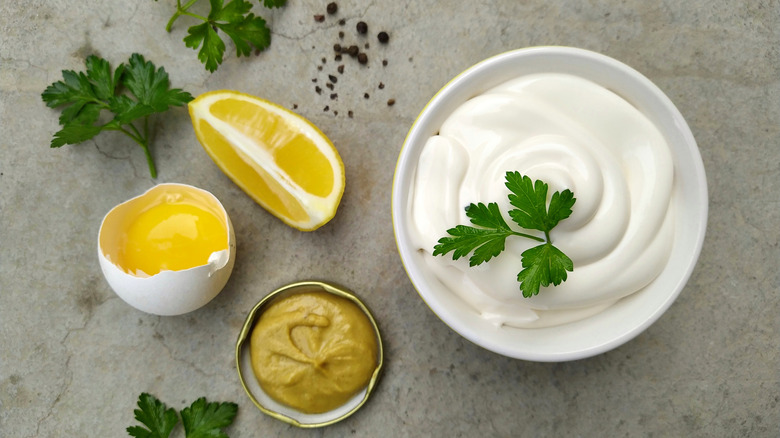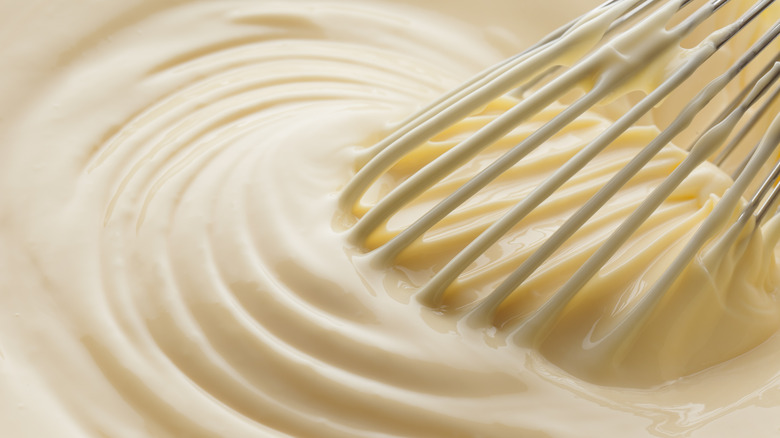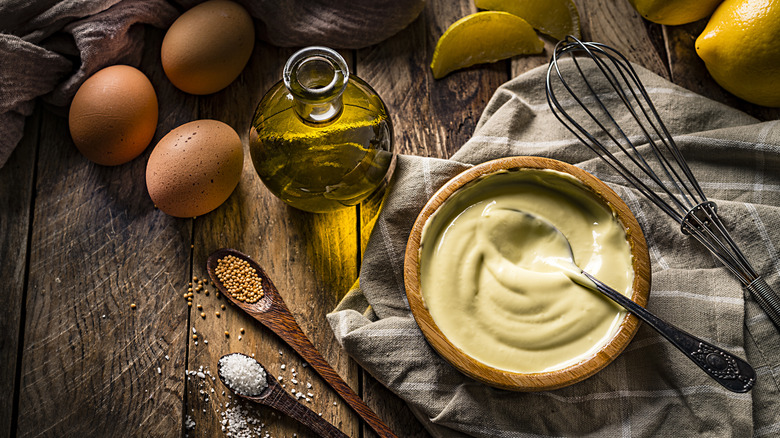Why Mayonnaise Is White Instead Of Yellow, According To Science
As you're dicing hard-boiled eggs and mixing them with a good dollop of mayonnaise to make a classic egg salad for lunch, have you ever stopped to wonder: Why is the mayo white, when the egg yolks are largely yellow? Since mayo is made from eggs, where did all the yellow color go?
If you have ever wondered, it's not a stupid question. In fact, none other than author Stephen King has gone through the very same thought process, posing the question on X (formerly Twitter). While answers on the social media forum ranged from the sincere to the "no-idea," there are in fact several scientific reasons why most store-bought mayo is white. And they involve both the ingredients, and the processes used to make the condiment.
The basic ingredients for making homemade mayonnaise are just egg yolks, oil, and an acid such as lemon juice or vinegar, and the combo appears more yellow in tone when done DIY. But, commercial mayo has more oil and less eggs, as well as a host of other ingredients such as preservatives, which gives it a lighter color. The way store-bought mayo is mixed on a huge scale also adds more air, which contributes to the pale hue.
Aeration and emulsification lead to white mayo
Mayonnaise consists of tiny microscopic oil droplets suspended in a watery liquid, known scientifically as an oil-in-water emulsion, and it's made by combining oil and vinegar with egg yolks. The egg yolk contains an emulsifier known as lecithin, which works to bind, or emulsify, the two ingredients — oil and vinegar — which would not otherwise naturally mix. Essentially, it's what makes the mayonnaise smooth and stable.
To combine the ingredients at home, you'd likely use a whisk or stick blender. This adds air to the mix, and the aeration also oxidizes the mayo. You'll see, as you continue to whisk, that this process makes the mixture turn from bright yellow to a paler color as it becomes more aerated.
When mayo is made commercially, there is heavy machinery doing all this mixing on a large scale which, as you may imagine, is a more vigorous process than you'd ever be able to achieve in your home kitchen. And, more aeration means the blended product turns even lighter in color. In addition, the microscopic oil droplets present in mayo also reflect light, which — when reflected equally — makes it appear whiter.
Different ingredients in homemade mayo make it more yellow
While the ingredients for homemade mayo are simple, the ingredients in an average jar of store-bought mayo might look a little different. To start with, egg yolks are the main ingredient in the homemade version, which contributes to the naturally yellowish tone. Commercial mayo, meanwhile, can contain up to around 80% oil, which means there's much less egg in the ratio, and more oil, and that makes store-bought mayo more viscous as well as whiter.
There may also be other proteins in a jar of mayo, which can be used in addition to egg yolks (or instead of, in the case of vegan mayo) to stabilize the oil-in-water emulsion. Ingredients such as soybean protein or other plant proteins may be utilized for this purpose as well. Other ingredients in some store-bought mayo, such as water, lemon concentrate, or preservatives, can also affect the color. Plus, many commercially produced mayos use whole eggs in addition to just the yolks, though there are exceptions; some brands, such as Kewpie, use solely egg yolks, which help give it a richer yellow color.
So, the next time you're wondering why your mayo is white, there are a number of scientific factors at play, from oil particles to the aeration processes. And if you prefer your mayo to look more yellow, the solution is probably just to make it yourself.



